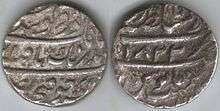Bhangi Misl

|
Sikh Confederacy (1707–1799) |
|
Phulkian Misl ·
Ahluwalia Misl ·
Bhangi Misl ·
Kanheya Misl ·
Ramgarhia Misl ·
Singhpuria Misl ·
Panjgarhia Misl ·
Nishanwalia Misl ·
Sukerchakia Misl ·
Dallewalia Misl ·
Nakai Misl ·
Shaheedan Misl
 |
The Bhangi Misl (Punjabi: ਭੰਗੀ ਮਿਸਲ (Gurmukhi), بھنگی مسل (Shahmukhi)) was a large Sikh Misl led by Dhillon Jats[1] headquartered in a village near Amritsar. It was founded in the early 18th century by Sardar Chhajja Singh,[1][2][3] who was baptised by Baba Banda Singh Bahadur.[4][5] The misl received its name "Bhangi" because Chhajja Singh and his soldiers were addicted to an intoxicant herb Bhang (drink made from cannabis sativa).[6][7] After Sardar Chhajja Singh's death, the Bhangi misl was succeeded by Bhuma Singh Dhillon.[4][8]
Expanse of Bhangi Misl
It grew in strength and territory to cover an area from Attock to Multan and emerged as the strongest power in the western Punjab region.[9] However, deaths among the leadership during the late 1760s reduced the Misl's power.[9]
Decline of Power
The Bhangi misl engaged in numerous power struggles with the Sukerchakia Misl until they were severely weakened at the Battle of Basin and the loss of Lahore to Ranjit Singh.
Bhangi Misl held the possession of Zamzama, the famous cannon, which was at the time named Bhangi Toap, Bhangianwala Toap and Bhangian di Top, names it retains to this day.[10]
See also
- Dhar (guerrilla warfare) audacious daring tactic of Dhillon Bhangi Misl, Jat and Marathas warriors
- Jat
- Gokula Jat nemesis of Aurangzeb
- Hinduism
- Raja Ram Jat
- Shivaji
References
- 1 2 Sikh History (2004). "The Bhangi Misal", History of the Sikhs, 2004. Retrieved on 7 September 2016
- ↑ Singh, Rishi (2015). State Formation and the Establishment of Non-Muslim Hegemony:Post-Mughal 19th-century Punjab. India: Sage Publications India Pvt Ltd, New Delhi, 23 April 2015. ISBN 9789351500759
- ↑ Dhavan, Purnima (2011). When Sparrows Became Hawks: The Making of the Sikh Warrior Tradition, 1699-1799, p.60. OUP USA Publisher, 3 November 2011.
- 1 2 Sandhu, Jaspreet Kaur (2000). Sikh Ethos: Eighteenth Century Perspective, p.99. Vision & Venture, Patiala, 2000.
- ↑ Jain, Harish (2003). The Making of Punjab, p. 201. Unistar Books Pvt. Ltd, Chandigarh.
- ↑ Singh, Bhagata (1993). A History of The Sikh Misals, p. 89. Publication Bureau, Punjabi University, Patiala, 1993.
- ↑ Seetal, Sohan Singh (1981). The Sikh Misals and the Punjab States, p.11. India: Lahore Book Shop, Ludhiana, 1981.
- ↑ Singh, Khushwant (2004-10-11). A History of the Sikhs: 1469-1838. Oxford University Press. p. 127. ISBN 978-0-19-567308-1.
- 1 2 McLeod, W. H. (2005-07-28). Historical dictionary of Sikhism. Rowman & Littlefield. pp. 35–. ISBN 978-0-8108-5088-0. Retrieved 10 July 2010.
- ↑ Singh, Khushwant A History of the Sikhs, Volume 1: 1469-1839. Oxford University Press, 2004, Page 198, Footnote 11